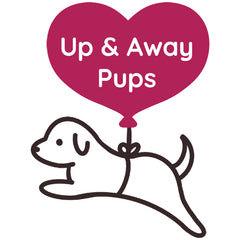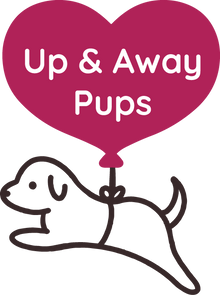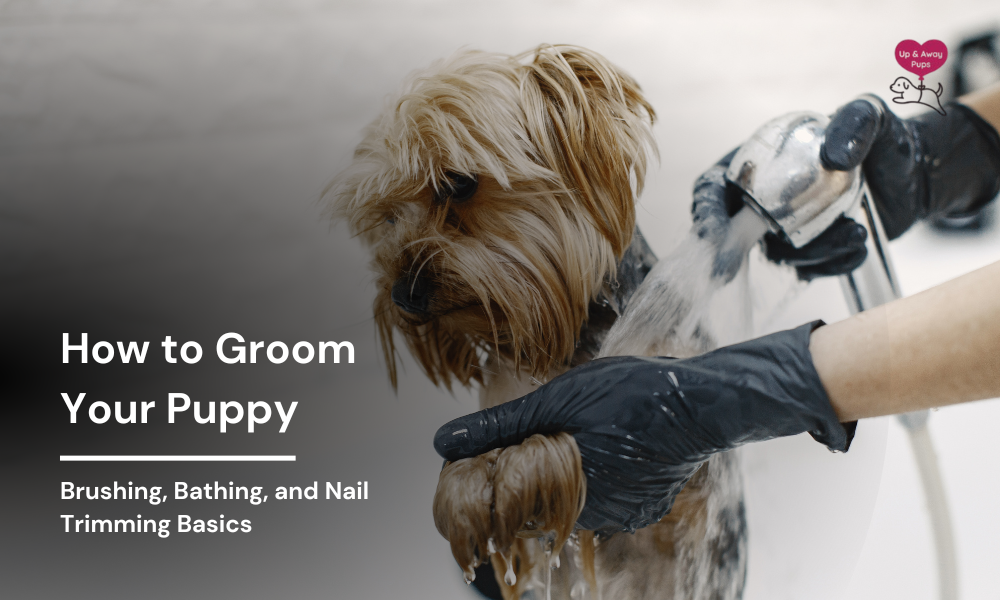How to Groom Your Puppy: Brushing, Bathing, and Nail Trimming Basics
Grooming is essential for your puppy’s health and happiness. Regular grooming helps prevent skin issues, control shedding, and check for health problems. Bathing should be done every 4-6 weeks to avoid stripping natural oils. Brushing frequency depends on coat type, with short-haired breeds requiring weekly brushing and long-haired breeds needing more frequent care. Nail trimming should be done every 3-4 weeks. Additionally, ear cleaning, dental care, and eye maintenance are crucial. Establishing a positive grooming routine will ensure your puppy stays comfortable, healthy, and well-groomed.
When you bring a new puppy into your home, it is one of the best days of your life. This tiny little thing, delighted at the sight and scent of you, constantly wagging its tail, being playful and cuddling up with you every chance it gets is now going to be your new best friend.
However, whilst dog’s are our best friends, they’re also like our kids, hence the phrase “pet parent”. So, as parents, you must groom your pup properly in order to raise them clean adn healthy.
Regular grooming not only keeps your puppy looking their best but also contributes to their overall health and well-being. So, in this blogpost, let’s go over the grooming basics.
Why Grooming Matters
Thinking about grooming for us humans? Why do we go take a bath, cut our nails, clean our ears, and so on and so forth? Sure, it is part of our beauty routine, but it is also absolutely necessary for maintaining hygiene and thus our health.
The very same logic applies to our furry little friends. For them, grooming is a vital part of their overall health care. With regular brushing and bathing, skin issues can be avoided, and excessive shedding can be controlled. Needless to say, keeping fur under control keeps the puppy comfortable as well.
Additionally, grooming sessions provide an excellent opportunity to check for signs of health problems, such as skin infections, parasites, or abnormalities which may otherwise might not have been spotted, or easily spotted at least.
Bathing Your Puppy
Dogs, generally speaking, either love bathing or absolutely despise it. However, the latter is only the case if they’re not introduced positively to the water. Bathing is necessary in order to keep their coats clean and skin healthy, so might as well do all you can to make sure it's actually a positive experience for them.
Bathing your puppy is essential for keeping their coat clean and their skin healthy. However, it's important to approach bath time with care to ensure your puppy has a positive experience.
When to Bathe
Puppies don’t need frequent baths, and in fact, over-bathing can lead to the removal of natural oils their skin produces, which leads to dryness and irritation. As a general rule of thumb, a bath a month is more than enough. If your puppy gets particularly dirty or has a skin condition, then they might require more frequent bathing.
Puppies generally don't need frequent baths. Over-bathing can strip natural oils from the skin, leading to dryness and irritation. A bath every 4 to 6 weeks is usually sufficient, unless your puppy gets particularly dirty or has a skin condition that requires more frequent bathing.
Preparing for Bath Time
Before jumping into the tub, you’d need to brush your puppy’s coat. Remove any tangles, knots, or loose fur beforehand. This way, when you’re soaping up the pup, your hands don’t get stuck anywhere, making the cleaning process more effective and comfortable for you and the puppy.
Also, use lukewarm water and a gentle puppy shampoo. You don't want water that is too cold or hot, and also, avoid getting water or shampoo in the pup’s eye, ears or nose.
Bathing Tips
• Use a detachable shower head or a cup to gently wet your puppy's coat.
• Lather the shampoo thoroughly, then rinse completely to remove all residue.
• Dry your puppy with a soft towel, gently patting their coat to absorb moisture.
• If your puppy is nervous about bath time, try to make the experience positive by offering treats and praise. Also, the sooner you introduce the concept of bathing to them, the better. If you have another pup they can watch, this helps normalize bathing more.
Brushing Your Puppy
After a shower, the hair needs brushing. It is the same case, as expected, with our four-legged friends here. The frequency and type of brush you use, however, depend upon the type of coat your puppy has. Having an understanding of different dog coat types really helps here.

Coat Types and Brushing Needs
• Short-haired breeds (e.g., French Bulldog or Pug): Brushing your pup once a week is plenty, as short-haired breeds don’t have a lot of fur and so their hair doesn’t knot up or tangle.
• Medium to long-haired breeds (e.g., Cocker Spaniels, Poodles): Brush several times a week to prevent mats and tangles; otherwise, the only option left is cutting or trimming.. Use a slicker brush or a comb designed for your puppy's coat type.
Brushing Tips
• The sooner you start brushing, the better, for it gets the puppy accustomed and, thus, desensitized to the process.
• Be gentle and patient in the beginning. You don’t want the pup to feel any pain, so use short strokes in the direction of hair growth.
• When brushing areas prone to matting, like under the arms (or legs, to be exact), behind the ears, the belly, or the collar area, be gentle but pay extra attention.
• Regular brushing also provides an opportunity to check for parasites like fleas or ticks.
Nail Trimming
If your dog walks a lot outside, their nails naturally file themselves down. However, if your dog only walks on soft surfaces or doesn’t go out that often, and has overgrown nails, they will cause pain, affect their gait and, worst case scenario, even lead to an injury. So, for their comfort and safety, it is best to check them every so often and trim them.
When to Trim
Nails should be trimmed regularly, typically every 3 to 4 weeks. If you hear clicking sounds when your puppy walks on hard surfaces, it's time for a trim. Again, this varies depending upon how active your dog is outside
How to Trim
• Ideally, its best to use dog nail clippers, not the nail-cutter/clippers we use for ourselves. This is both hygienic and practical as nail clippers designd for pets are, obviously, more effective at the job.
• Hold your pup’s paw gently and lcate the pink area within the nail that contains blood vessels and nerves. This is the part you don’t have to cut, stay further ahead from it. This part is referred to as the quick and must be avoided.
• If you accidently do cut the nail and bleeding occurs, apply styptic power to stop the bleeding.

Tips for Success
• Start handling your puppy's paws early to get them used to the sensation.
• Reward your puppy with treats and praise during and after nail trimming sessions to create a positive association.
• If you're unsure or uncomfortable trimming your puppy's nails, consult a professional groomer or veterinarian.
Additional Grooming Tips
We may be putting these under the “additional” grooming tips section, but that isn’t to imply these are optional. All of the below are just as important as those mentioned above.
Ear Cleaning: Ears are self-cleaning, but you do need to help your dog every now and then. If you notice your puppy scratching more often, it may be a sign of infection. Look for redness, odor or excessive wax. In order to clean the ear, use a vet-approved ear cleaner and a cotton ball to gently clean the outer ear canal; do not go too deep.
Dental Care: It is best to introduce your puppy to brushing their teeth as soon as possible. Use a toothbrush and toothpaste formulated for dogs and make this a regular habit for it prevents plaque buildup, keeps their breath bearable and promotes overall health.
Eye Care: Aside from the general removal of eye dust, keep a lookout for signs of redness, discharge, or irritation in your puppy. Use a damp cloth to gently wipe away any debris.
Conclusion
Grooming your puppy is an essential part of their care routine that contributes to their health, comfort, and happiness. By establishing a regular grooming schedule and using the appropriate tools and techniques, you can ensure that your puppy grows up to be a healthy and well-groomed adult dog. Remember, grooming is also an opportunity to bond with your puppy and build trust, making it a positive experience for both of you.
Frequently Asked Questions
How Often Should I Bathe My Puppy?
Bathing frequency depends on your puppy's breed and activity level. Generally, a bath every 4 to 6 weeks is sufficient. Over-bathing can strip natural oils from their skin, leading to dryness and irritation.
What Type of Brush Is Best for My Puppy?
The best brush depends on your puppy's coat type. Short-haired breeds benefit from a soft bristle brush, while medium to long-haired breeds may require a slicker brush or comb to prevent mats and tangles.
How Can I Make Nail Trimming Less Stressful for My Puppy?
Start handling your puppy's paws early to get them accustomed to the sensation. Use positive reinforcement, such as treats and praise, during and after nail trimming sessions to create a positive association.


